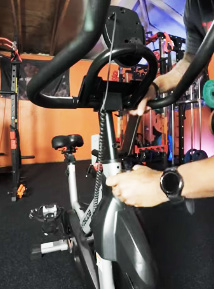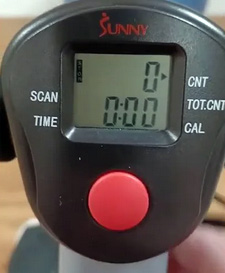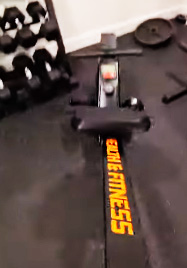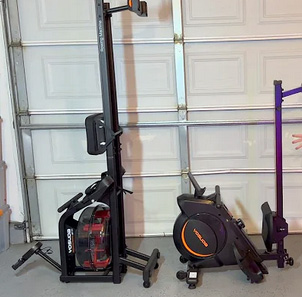I’ve been on a mission to find the perfect rowing machine for my home gym without breaking the bank, and after sweating it out on both the Yosuda and Sunny Health & Fitness models, I’m ready to share my experience. This article is all about comparing these two budget-friendly rowing machines, breaking down their pros and cons, and helping you decide which one fits your fitness goals. From build quality to performance, I’ll give you the real scoop from a user’s perspective, so you can choose the rower that’ll keep you motivated and moving.
Comparison Table
| Feature | Yosuda Magnetic Rowing Machine | Sunny Health & Fitness SF-RW5801 |
| Resistance Type | Magnetic (16 levels) | Magnetic (16 levels) |
| Weight Capacity | 350 lbs | 330 lbs |
| Dimensions | 48 x 21.7 x 20.5 inches | 80.1 x 21.8 x 52.7 inches |
| Product Weight | 60 lbs | 68 lbs |
| Foldable | Yes | Yes |
| Monitor | LCD (Time, Distance, Calories, Stroke Count) | LCD (Time, Distance, Calories, Stroke Count) |
| Bluetooth Connectivity | Yes (some models, e.g., Magnetic Pro) | No |
| Tablet Holder | Yes | Yes |
| Noise Level | Very quiet (<30 dB) | Quiet, but some report clicking |
| Price (Approx.) | $200-$350 | $225-$300 |
| Warranty | 2 years | 1 year |
My Journey With Rowing Machines

Let me set the scene: I’m no Olympic rower, but I’ve always loved the idea of a full-body workout that’s low-impact yet intense enough to make me feel like I’ve conquered a mountain. After years of dabbling with treadmills and stationary bikes, I decided to give rowing a shot. The problem? My budget wasn’t exactly screaming “buy a $1,000 Concept2.” So, I turned to two brands that kept popping up in my research: Yosuda and Sunny Health & Fitness. Both are known for affordable, reliable fitness gear, but I wanted to know which one would truly deliver for someone like me—a regular person looking to stay fit at home.
I spent weeks testing the Yosuda Magnetic Rowing Machine (specifically the Magnetic Pro model) and the Sunny Health & Fitness SF-RW5801. I rowed in my living room, tracked my stats, and even dragged my husband into testing them for a second opinion. What follows is my honest take on how these machines stack up, from their build to their performance, with all the pros and cons laid bare.
Yosuda Magnetic Rowing Machine: My Experience
Also Read: Comparison Between Planet Fitness And Fitness 19.
When I first unboxed the Yosuda, I was pleasantly surprised by how sturdy it felt for a budget rower. The steel frame gave me confidence that it wouldn’t wobble during intense sessions, and at 60 pounds, it was light enough for me to move around my small apartment. The assembly was a breeze—about 20 minutes with clear instructions and all the tools included. I was rowing within half an hour of opening the box, which is a win for someone as impatient as me.
Key Features Of The Yosuda
The Yosuda uses a magnetic resistance system with 16 levels, which I found versatile enough for both my beginner-level workouts and the occasional high-intensity sessions. The flywheel, at 10 pounds, provides a smooth, consistent pull that feels natural. The seat is padded and comfortable, even after 30-minute sessions, and the non-slip pedals with adjustable straps kept my feet secure. The LCD monitor tracks time, distance, calories, and stroke count, which was enough for me to gauge my progress. Some models, like the Magnetic Pro, even offer Bluetooth connectivity, letting me sync with apps like Kinomap for virtual rowing experiences.
One standout feature is the tablet holder. I propped up my iPad to stream workouts, and it stayed put even when I was rowing hard. The machine is also foldable, which is a lifesaver in my cramped space. I could tuck it away in a corner when not in use, and the transport wheels made moving it effortless.
Pros Of The Yosuda

- Quiet Operation: The magnetic resistance is whisper-quiet, under 30 dB. I could row at 6 a.m. without waking my husband or the neighbors.
- Sturdy Build: The 350-pound weight capacity and steel frame make it feel like a premium machine, despite the budget price.
- Easy Assembly: I had it set up in under 30 minutes, and the instructions were foolproof.
- Foldable Design: Perfect for small spaces, it folds up neatly and stands upright.
- Bluetooth Connectivity (Select Models): The Magnetic Pro’s app compatibility added a fun, interactive element to my workouts.
- Comfortable Ergonomics: The padded seat and adjustable foot straps made long sessions comfortable.
- Affordable Price: At $200-$350, it’s a steal for the features you get.
- Two-Year Warranty: Yosuda’s commitment to customer satisfaction gave me peace of mind.
Cons Of The Yosuda
- Limited Resistance for Pros: The 16 levels are great for beginners and intermediates, but serious rowers might find the highest setting too easy.
- Basic Monitor: The LCD is functional but lacks advanced features like stroke rate or pre-set workouts.
- No Water Resistance: Despite some models being marketed as “Magnetic/Water,” it’s magnetic only, which disappointed me as I wanted that authentic rowing feel.
- Footrest Positioning: If you’re super flexible or tall, the footrests might feel too close, limiting your stroke length.
- Assembly Time for Some: While I found it easy, a few users reported needing an hour or help for setup.
Sunny Health & Fitness Sf-Rw5801: My Experience
The Sunny SF-RW5801 arrived a few days after the Yosuda, and I was excited to compare them. It’s slightly heavier at 68 pounds, but still manageable for moving around. Assembly took about 30 minutes, similar to the Yosuda, though I noticed the instructions weren’t quite as polished. Once set up, the machine looked sleek and sturdy, with a 330-pound weight capacity that felt reassuring for my 200-pound husband.
Key Features Of The Sunny
Like the Yosuda, the Sunny uses magnetic resistance with 16 levels, offering a smooth and customizable workout. The LCD monitor tracks the same basics—time, distance, calories, and stroke count—but lacks Bluetooth or app connectivity. The seat is wide and padded, and the angled handlebars were a nice touch for comfort. The machine is foldable, with wheels for easy storage, and it comes with a tablet holder, which I used to watch Netflix during lighter sessions.
One thing I noticed immediately was the slide rail length. At 43 inches, it’s shorter than the Yosuda’s 48 inches, which made a difference for my 6-foot-tall husband. He felt slightly cramped, but it was fine for my 5’6” frame.

Pros Of The Sunny
- Smooth and Quiet: The magnetic resistance is nearly silent, though some users report a clicking sound over time.
- Solid Construction: The steel frame supports up to 330 pounds and feels durable during vigorous rowing.
- Affordable: Priced between $225-$300, it’s competitively priced for a budget rower.
- Comfortable Design: The padded seat and angled handlebars make for a pleasant rowing experience.
- Foldable: It folds easily, making it ideal for small apartments.
- Tablet Holder: Great for streaming workouts or entertainment.
- Low Maintenance: Magnetic resistance means no upkeep, unlike water rowers.
Cons Of The Sunny
- Shorter Slide Rail: The 43-inch rail might limit taller users’ range of motion.
- No Bluetooth: Unlike some Yosuda models, there’s no app connectivity, which felt like a missed opportunity.
- Clicking Noise Issues: Some users, including me after a few weeks, noticed a faint clicking from the resistance drum, which required lubrication to fix.
- Basic Monitor: Like the Yosuda, the LCD is simple and doesn’t track strokes per minute.
- One-Year Warranty: Shorter than Yosuda’s, which could be a concern for long-term durability.
- Less Polished Instructions: Assembly was straightforward but not as user-friendly as Yosuda’s.
Head-To-Head: Yosuda Vs. Sunny
Now that I’ve rowed on both, let’s break down how they compare in key areas.
Also Read: Comparison Between Planet Fitness And Fitness 19.
Build Quality and Durability
Both machines impressed me with their sturdy steel frames, but the Yosuda edges out slightly with its 350-pound weight capacity compared to the Sunny’s 330 pounds. I felt confident pushing hard on either, but the Yosuda’s slightly lighter weight (60 lbs vs. 68 lbs) made it easier to move. Both are built to last, but Yosuda’s two-year warranty versus Sunny’s one-year gives it a slight advantage for peace of mind.
Resistance and Performance
The magnetic resistance on both is smooth and quiet, with 16 levels to suit beginners to intermediates. I found the Yosuda’s resistance slightly more consistent, with no noticeable lag when switching levels. The Sunny, while smooth initially, developed a faint clicking sound after a month, which I fixed with some machine oil. For casual rowers like me, both provide enough challenge, but neither will satisfy competitive rowers craving intense resistance.
Comfort and Ergonomics
The Yosuda’s padded seat and adjustable foot straps felt tailor-made for long sessions. The Sunny’s seat is equally comfortable, and I liked the angled handlebars for a natural grip. However, the Sunny’s shorter slide rail was a drawback for my husband, who couldn’t fully extend his legs. If you’re taller than 6 feet, the Yosuda’s longer rail is a better bet.
Technology and Features
Here’s where the Yosuda pulls ahead. The Magnetic Pro model’s Bluetooth connectivity let me sync with apps like Kinomap, adding virtual rowing routes that kept me engaged. The Sunny lacks this feature, which was a bummer since I had to rely on my phone or tablet for workout guidance. Both have basic LCD monitors, but they get the job done for tracking essentials. The tablet holder on both was a godsend for streaming.
Storage and Portability
Both machines are foldable and have transport wheels, making them ideal for small spaces. The Yosuda’s lighter weight and slightly more compact folded size (about 4.5 square feet) made it easier to store in my closet. The Sunny’s slightly larger footprint was noticeable in my tiny apartment, but it’s still manageable.
Price and Value
Price-wise, both are budget champs. The Yosuda ranges from $200-$350, depending on the model, while the Sunny sits at $225-$300. The Yosuda’s extra features, like Bluetooth and a longer warranty, make it feel like a better value, especially if you snag it on sale. The Sunny’s solid performance and slightly lower price point make it a strong contender for those who don’t need app connectivity.
Customer Service
Yosuda’s customer service stood out. When I had a question about assembly, they responded within 24 hours and even offered to send replacement parts if needed. Sunny’s support was decent, but I read mixed reviews about response times, and their shorter warranty felt less reassuring.
My Real-World Testing: A Week In The Life

To give you a sense of how these machines fit into daily life, I incorporated both into my routine for a week. I’m a 35-year-old mom with a full-time job, so my workouts are usually 20-30 minutes in the early morning or evening. Here’s how it went:
- Monday (Yosuda): I started with a 20-minute session at resistance level 4, streaming a Kinomap workout. The quiet operation let me row while my toddler slept, and the app’s virtual river route made it fun. The seat was comfy, and I felt energized.
- Tuesday (Sunny): I tried a 25-minute HIIT session at level 6. The resistance felt solid, but the shorter rail meant I had to adjust my form slightly. The tablet holder kept my phone steady for a YouTube workout video.
- Wednesday (Yosuda): I pushed to level 8 for a 30-minute steady-state row. The Bluetooth sync was seamless, and the monitor’s calorie count motivated me to keep going. No noise complaints from my husband.
- Thursday (Sunny): I noticed the clicking sound during a 20-minute session at level 5. It wasn’t loud, but it bugged me until I lubricated the coil spring. The workout was still effective, and the handlebars felt great.
- Friday (Yosuda): A 25-minute session at level 7 with a Netflix show on my iPad. The smooth glide and long rail made it my favorite session of the week. I felt like I could row forever.
- Saturday (Sunny): My husband took it for a spin at level 10. He grumbled about the rail length but liked the resistance. We folded it up afterward, and it fit nicely in our storage nook.
- Sunday (Yosuda): I ended with a 30-minute low-intensity row at level 3, focusing on form. The foot straps kept me secure, and the machine’s stability was reassuring.
Both machines fit into my life, but the Yosuda’s tech features and longer rail made it my go-to. The Sunny was solid but felt slightly less polished.
Which One Should You Choose?
If you’re like me—a beginner or intermediate rower looking for an affordable, reliable machine—the Yosuda is hard to beat. Its Bluetooth connectivity, longer warranty, and slightly better ergonomics for taller users make it a standout. It’s perfect if you want a touch of tech to keep you motivated and have limited space. The Sunny is a great alternative if you’re on a tighter budget and don’t mind the lack of app integration. It’s sturdy and comfortable but might frustrate taller users or those sensitive to minor noises.
Frequently Asked Questions
It depends on your needs. Yosuda offers better tech and warranty, while Sunny is a solid budget pick. For premium quality, Concept2 is the gold standard.
Magnetic rowers like Yosuda and Sunny are quiet and low-maintenance, ideal for home use. Water rowers feel more authentic but require upkeep. Air rowers like Concept2 are durable but louder.
Yes, rowing works 86% of your muscles, burns calories, and boosts cardio. Pair it with a balanced diet for optimal results.
Cheap rowers ($200-$500) like Yosuda and Sunny offer basic features, magnetic resistance, and solid builds but lack advanced tech or high resistance. Expensive rowers ($800+) like Concept2 or Hydrow have durable frames, variable resistance, and interactive features.
Conclusion
Also Read: Comparison Between Planet Fitness And Fitness 19.
After rowing my heart out on the Yosuda and Sunny, I’ve learned that both are fantastic budget options, but they cater to slightly different needs. The Yosuda’s tech-savvy features and longer warranty make it my top pick for a versatile, home-friendly rower. The Sunny holds its own with solid performance and a lower price, though it’s less ideal for taller users or tech enthusiasts. Whichever you choose, you’re getting a reliable machine that’ll help you stay fit without emptying your wallet. So, grab a rower, start pulling, and let’s make those fitness goals a reality!
